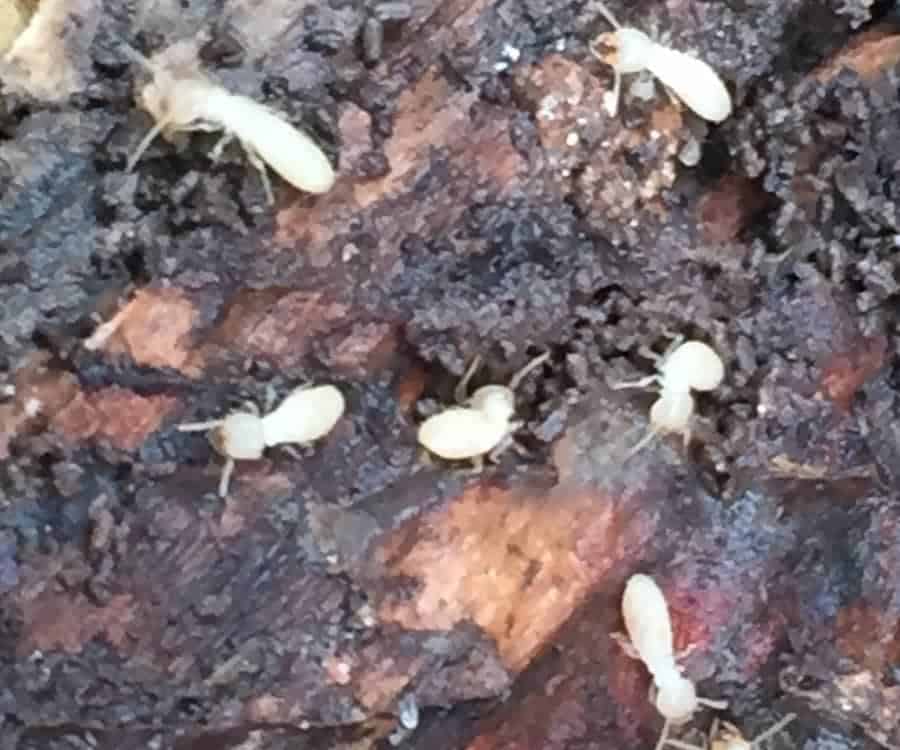This is a great question, in fact, if I hadn’t worked in the pest industry for many years I would never know the answer to this question because it is not as obvious as one would think.
So how do I make sure I don’t have termites? Some of the tell-tale signs you have termites may be:
- Small Winged Insects Flying Around Your Property
- Mud Tunnels Coming From The Ground Up Towards Your Foundation
- Translucent Wing Piles Around Window Sills, Doors, Vents and Light Fixtures of Your Home
What Is The First Sign Of Termites?
This is an unfair question… The reason I say that is because if you are asking this question you probably don’t know what part of the process your home may or may not be in. So here it is: In the spring when the swarmers come out that is the first true sign of termites, although little to no damage has taken place as they make their short flight to their new home. They then shed their wings when they find their new home.
Searching for evidence of termites can be difficult to discover.
In order to make sure you don’t have an infestation you will want to check these things.
Mud Tubes – provide shelter for termites it is the size of a pixy stick and you can find them heading from the footer of your foundation up to the joists that support the floor. You can find mud tubes around the baseboards, on pipes, support piers, around plumbing, and other fixtures.
Check The Wood – another way to make sure you don’t have termites would be taking a large flathead screwdriver and tap the hardwood along the walls and baseboards. If you have an infestation you will hear a hollow sound in the wood. When you check the basement or crawl space make sure to look up near the insulation and use the sharp edge of the screwdriver to check joists and wood members.
Just to give you an idea, Termite colonies can withstand harsh weather. A queen termite can live up to 25 years laying thousands of eggs a day. The worker termites can live 2-5 years. If not treated these colonies will spread into more colonies. The average home with an infestation will have over 500,000 termites in it! You can expect that number to grow thousands daily.
How Much Damage Do Termites Do?
This is mind-blowing. The amount of damage caused by termites annually is 5 billion dollars. With more than 4 million homes in the United States at risk every year, this is something that can’t be ignored. A home with a termite infestation that goes untreated can be completely gutted floor to ceiling in a matter of months.
Termites cause more damage to homes than any natural disaster.
There are about 20 species of termite that cause structural damage in the United States
The Three Most Common Are:
- Drywood Termites
- Formosan Termites
- Subterranean Termites
What Else Should I Know About Termites?
Swarmers or winged termites you will see pop up in the springtime and they will head towards a well-lit area. After a short journey, the male and female swarmer will find a place to mate and build their colony. Most time is spent in wood or moist dirt. The worker termites are white or see-through and they do most of the damage to structures. Worker termites will move fast when not protected from sunlight because they will dry out easy and die when not protected.
What Attracts Termites In The House?
The name of the game is moisture. Subterranean termites thrive in moist environments, they will build their colony in the dirt under the foundation of your home. Every time I inspect a crawl space or basement I carry a moisture meter to make sure the wood is under 15% moisture. If those areas of your home get higher than that you may have to worry about mold spores as well. So the moisture is the first thing that attracts them and the second thing is obviously wood. Termites are not very picky when it comes to wood, they will eat anything from antique furniture to structural wood.
So How Do I Get Rid Of Moisture?
There are companies out there that will encapsulate your crawl space and put in a dehumidifier for a good chunk of change. Encapsulating your crawlspace is done by using a 20 mil polyethylene, it is sealed to the walls of the crawl space and around all pillars and the floor. All the vents are sealed off with a foam board and silicone.
If your home has a problem everytime it rains or snows with moisture or standing water you may want to consider putting in a drain system with a sump pump. If you decide to do one or both of these it could run you anywhere from 3-10 thousand dollars. These 2 things will ensure that your home will be sealed off from moisture.
How Do Exterminators Treat For Termites?
There are 3 treatment types an exterminator may use depending on the size and place of the infestation. To take on a large infestation of termites you will more than likely need a spray treatment around the foundation.
A spray treatment requires getting down in the dirt all the way to the footer with a mattock and drilling every 12-16 inches along the concrete or asphalt foundation points.
A foam treatment can be used in wall voids and pipe areas under sinks and all those places that are unable to be reached by the spray treatment.
A bait system treatment is a monitoring treatment where there are interceptors that are used to attract termites to those systems first. These should be checked every 3-4 months to make sure there are no signs of termites. If the technician does find termites in the bait system they will put a termiticide in the system to kill the beginnings of the problem to ensure there is no further infestation.
Did You Know You Can Monitor For Termites On Your Own?
What Can I Do To Prevent Getting Termites?
Here are some things you can personally do to prevent getting termites
- Keep debris and loose wood away from the outside of your home
- Make sure you don’t have moisture issues underneath your home, you can use a moisture meter and as long as you are under 15% moisture you are in good shape. Make sure when you use a moisture meter that you put the prongs in the wood in multiple places so you can get a good average reading.
- Termite Bait Stations – You can buy a set of 10 or 20 bait stations online to monitor your home for termites. You should place the stations every 10 linear feet around the foundation of your home. Make sure you put the stations 3-8 feet away from the foundation so the termites that get in the station don’t spread to your foundation by accident. You should check these stations every 3-4 months to monitor. Slugs and other bugs may get into the station as well termites will make distinct grooves in the wood, so when you are monitoring this make sure you, in fact, have termites before you react.
- Once a year it is a good idea to inspect your home for termites in case there are some that have made it into your home.
Summary
Just to recap, you can make sure you don’t have termites in or around your home. If you are diligent in keeping your home dry and free of wood it will increase your chances of not getting them. If you want to take it a step further you can definitely monitor them yourself. If you are ever in doubt and you don’t want the hassle you can call the pros.
Other Posts Of Interest
What Time Of Year Do Spiders Lay Their Eggs?
I have always wondered about this even before I became a pest exterminator.
What time of year do spiders lay their eggs? The brief answer is spider multiply all year. Even though they will appear less active in the winter and fall they will still mate, lay eggs and feed.
What Do Exterminators Do To Stop A Mouse Problem?
I had a friend recently tell me his wife saw a mouse in their basement and he wondered if he should just set up traps or call an exterminator. He said he didn’t want to pay someone $300 dollars just to set a mouse trap.
So he googled… What do exterminators do to stop a mouse problem? Most Pest Applicators use poison to stop a mouse problem. If you are not a pesticide person and you don’t mind disposing of mouse carcasses traps work too. There is, however, a refined technique that should be implemented.
The most common places you will find mice will be:
- Under Sinks
- Around Water Heaters
- Under The Refrigerator
- Under The Stove/ Range
- Behind Washer and Dryer
- Under The Dish Washer
- Crawl Spaces
- Unfinished Basements
- Attics/Walls

